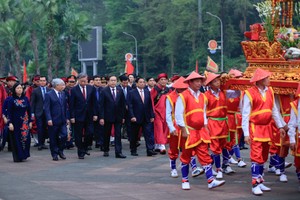
The participation in Geneva 1999 Act allows Vietnam the rights and duties only to all conditions in this agreement. Besides, Vietnam now has a right to discuss and vote for any issue raised for all acts in the agreement by the Lahay Alliance.
According to Minister Chu Ngoc Anh, the Lahay system is designed to allow the registration of industrial designs of any nation in need via only one application form, which is then submitted to WIPO using one approved monetary unit (the Swiss franc). This is much more convenient and time-saving for applicants to prepare all necessary procedures concerning protection registration, validity extension, intellectual property transfer.
Lately, the Lahay system has reported several noticeable improvements after the participation of developed economies like the US, Japan, the Republic of Korea, Russia, and Canada. ASEAN countries themselves are gradually joining in this advantageous agreement to simplify procedures to sign up for industrial designs, in hope of boosting the competitiveness of their own economies.
Statistics from the Intellectual Property Office of Vietnam, the percentage of industrial design application forms by foreign individuals and organizations has increased by 15 percent per year. The proportion in 2015 grew by 16 percent compared to the previous year, followed by a rise of 20 percent and 15 percent in 2016 and 2017 respectively.
However, there still exist certain difficulties regarding proper procedures and cost, partially restricting the growth of registration by Vietnamese people abroad as well as foreign people in Vietnam.
At the moment, any Vietnamese individual or organization wishing to sign up for their industrial design protection in other nations has no way but to directly submitting their application form to corresponding intellectual property offices. This means they need to prepare their form in many languages and meet the demands of each country separately, not to mention extra costs. The similar situation happens to foreigners who want to register for their industrial design in Vietnam.
Due to that troublesome fact, the Intellectual Property Office of Vietnam has to introduce suitable policies and actions to smooth the procedures, promoting trading activities between Vietnam and other nations. One such action is the participation in international agreements to simplify and harmonize needed procedures for intellectual property rights.
“Joining in Lahay Agreement answers real demands of domestic as well as international business people in signing up for their industrial designs. This action also ensures that Vietnam is fulfilling its commitment in the Euro-Vietnam Free Trade Agreement (EVFTA), the Comprehensive and Progressive Agreement for Trans-Pacific Partnership (CPTPP), and activities in ASEAN”, affirmed Minister Anh.
Waiting for related legal documents to be adjusted, Vietnam announced it is going to directly apply all regulations of Lahay Agreement to international registration of industrial designs in the country or from the country. The handling procedure of these international application forms in the national level will be treated according to current legal regulations, just like the national ones.
Obviously, Vietnam’s participation in Lahay Agreement is essential now that intellectual property is playing an increasingly important role in socio-economic development, leading to the need of simplifying and harmonizing procedures in accordance with international standards, especially for industrial design registration.
























